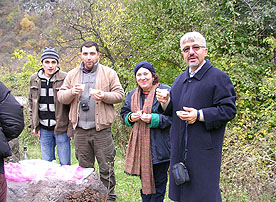Lessening the effects of earthquakes in the southern Caucasus
“The Caucasus is one of the most seismically active and hazardous regions in the Alpine-Himalayan collision belt,” explains Dr Niyazi Türkelli. He is one of the co-directors of a NATO-sponsored project aimed at building capacity and promoting cross-border cooperation in Armenia, Azerbaijan and Georgia with a view to mitigating the effects of earthquakes in the region.

Complex geological structure and active plate movements subject the Caucasus to strong, sometimes catastrophic, earthquakes. In the last few decades alone, several major earthquakes of magnitude 6.5-7 have shaken the region, including a 6.9 magnitude earthquake in Spitak, Armenia on 7 December 1988 that left 25 000 people dead, 20 000 people injured and over half a million people homeless.
“Among the numerous natural disasters that the countries of the world have experienced, earthquakes have historically had great impact,” points out Dr Türkelli, a professor in the Department of Geophysics of the Kandilli Observatory and Earthquake Research Institute at Boğaziçi University in Turkey.
Earthquakes are damaging to most countries, but for developing countries they can be especially devastating. In addition to the heavy toll they take in terms of human life, earthquakes can also destroy economic and social infrastructures. Mitigating the loss of life and destruction of property caused by earthquakes “requires clear understanding of the expected earthquake shaking character at various locations, and building and strengthening of structures according to expected earthquake impact,” says Dr Türkelli.
With this in mind, a three-year project was launched in May 2009, funded under the NATO Science for Peace and Security (SPS) Programme, to improve seismic hazard and risk analysis and develop emergency response teams. Armenia, Azerbaijan and Georgia work together to build interregional cooperation and encourage unimpeded response in case of a strong earthquake.
Experts from eight NATO member and partner countries – Armenia, Azerbaijan, Canada, Georgia, Greece, Italy, Turkey and the United States – are involved in the project.
Building capacity and promoting regional cooperation

Installed at various sites in Armenia, Azerbaijan and Georgia, this equipment will also help the three countries to develop a communication network that will allow data acquisition centres to exchange information on earthquakes.
“It’s very important for us, for people from different regions, to share our knowledge,” says Dr Tea Godoladze, Deputy Director of Institute of Earth Sciences at Ilia Chavchavadze State University in Georgia and a participant of the project.
The project also provides support for all three countries to organise, equip and train multidisciplinary teams. These teams will be able to conduct comprehensive seismic observations and hazard analysis, in addition to providing rapid response in emergency situations. Each team will also receive training on how to administer basic first aid and offer assistance to each other within 12-24 hours of an earthquake.
“Seismicity doesn’t stop at the border,” points out Dr Christiaan de Wispelaere, the SPS Advisor who oversees the project at NATO Headquarters. “It’s very important that these countries cooperate.”
Breaking down barriers
While developing a new generation of young scientists, the project has additional benefits: helping to rebuild working relationships between the countries involved.
Although tensions and substantial differences exist in the region, Dr Eileen Vergino, co-director of the project and Deputy Director for the Centre for Global Security Research at the Lawrence Livermore National Laboratory in the United States, believes this is an important first step. “I see it as an opportunity to move beyond some of the tensions and the history,” she says.
The project moves many of the participants and young scientists beyond political constraints by “breaking down some of the misconceptions and barriers,” points out Dr Vergino.
Dr Godoladze echoes her thoughts: “This is how to put people together, especially youngsters. You’re telling them that you’re not enemies.”
